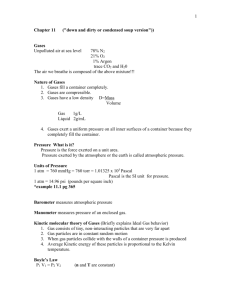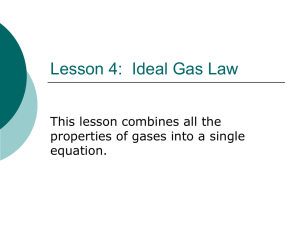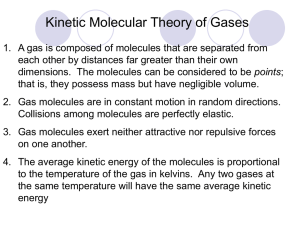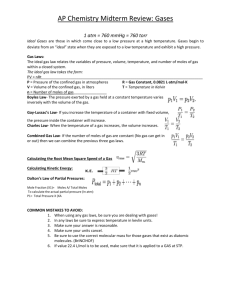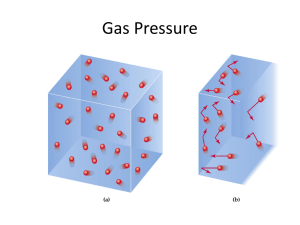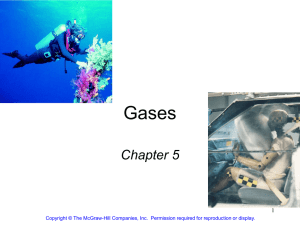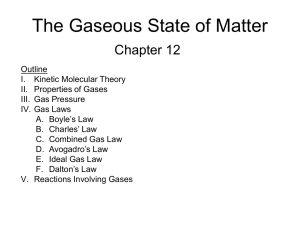Chapter 5 ppt annotated
advertisement
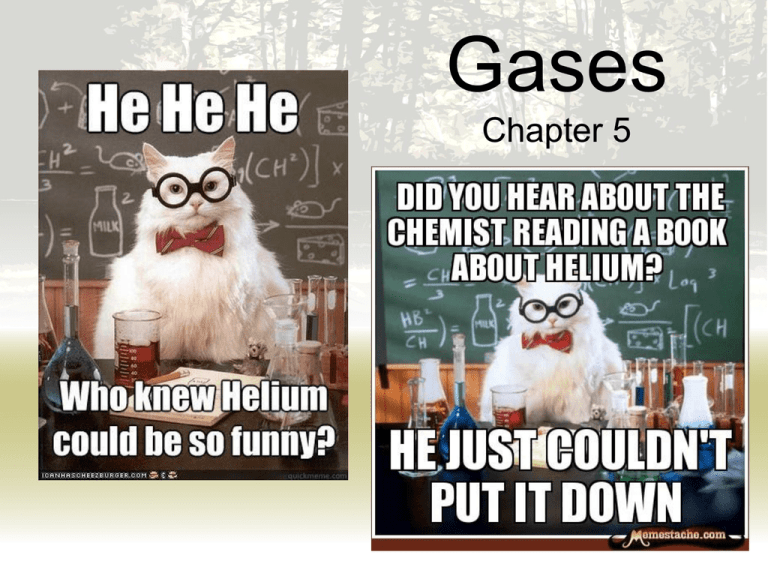
Gases Chapter 5 5.1 SUBSTANCES THAT EXIST AS GASES 2 Elements that exist as gases at 250C and 1 atmosphere 3 4 Physical Characteristics of Gases • Gases assume the volume and shape of their containers. • Gases are the most compressible state of matter. • Gases will mix evenly and completely when confined to the same container. • Gases have much lower densities than liquids and solids. 5 NO2 gas 5.2 PRESSURE OF A GAS 6 Force Pressure = Area (force = mass x acceleration) Units of Pressure 1 pascal (Pa) = 1 N/m2 1 atm = 760 mmHg = 760 torr 1 atm = 101,325 Pa 7 10 miles 4 miles Sea level 0.2 atm 0.5 atm 1 atm 8 Example 5.1 Page 177 The pressure outside a jet plane flying at high altitude falls considerably below standard atmospheric pressure. Therefore, the air inside the cabin must be pressurized to protect the passengers. What is the pressure in atmospheres in the cabin if the barometer reading is 688 mmHg? Manometers Used to Measure Gas Pressures closed-tube open-tube 10 11 5.3 THE GAS LAWS 12 Apparatus for Studying the Relationship Between Pressure and Volume of a Gas As P (h) increases V decreases 13 Boyle’s Law P a 1/V P x V = constant P1 x V1 = P2 x V2 Constant temperature Constant amount of gas 14 Example 5.5 Page 187 An inflated helium balloon with a volume of 0.55 L at sea level (1.0 atm) is allowed to rise to a height of 6.5 km, where the pressure is about 0.40 atm. Assuming that the temperature remains constant, what is the final volume of the balloon? A scientific research helium balloon. Variation in Gas Volume with Temperature at Constant Pressure As T increases V increases 16 Variation of Gas Volume with Temperature at Constant Pressure Charles’s & Gay-Lussac’s Law VaT V = constant x T **Temperature must be in Kelvin V1/T1 = V2 /T2 T (K) = t (0C) + 273.15 17 Variation PaT P = constant x T P1/T1 = P2 /T2 18 Example 5.6 Page 188 Argon is an inert gas used in lightbulbs to prevent the vaporization of the tungsten filament. A certain lightbulb containing argon at 1.20 atm and 18°C is heated to 85°C at constant volume. Calculate its final pressure (in atm). Electric lightbulbs are usually filled with argon. Avogadro’s Law V a number of moles (n) Constant temperature Constant pressure V = constant x n V1 / n1 = V2 / n2 20 Summary of Gas Laws Boyle’s Law 21 Charles’s Law 22 Avogadro’s Law 23 Ideal Gas Equation Boyle’s law: P a 1 (at constant n and T) V Charles’s law: V a T (at constant n and P) Avogadro’s law: V a n (at constant P and T) Va nT P V = constant x nT P =R nT P R is the gas constant PV = nRT 24 The conditions 0 0C and 1 atm are called standard temperature and pressure (STP). Experiments show that at STP, 1 mole of an ideal gas occupies 22.414 L. PV = nRT (1 atm)(22.414L) PV R= = nT (1 mol)(273.15 K) R = 0.082057 L • atm / (mol • K) 25 5.3 Sulfur hexafluoride (SF6) is a colorless and odorless gas. Due to its lack of chemical reactivity, it is used as an insulator in electronic equipment. Calculate the pressure (in atm) exerted by 1.82 moles of the gas in a steel vessel of volume 5.43 L at 69.5°C. Page 186 Combined Gas Law • Ideal gas law is useful when P, V, n, T are not changing, but at times we need to deal with changes in P, V, n, T Since, n1 = n2 27 5.7 Page 189 A small bubble rises from the bottom of a lake, where the temperature and pressure are 8°C and 6.4 atm, to the water’s surface, where the temperature is 25°C and the pressure is 1.0 atm. Calculate the final volume (in mL) of the bubble if its initial volume was 2.1 mL. 5.4 Page 186 Calculate the volume (in L) occupied by 7.40 g of NH3 at STP. Density (d) Calculations n = P V RT n= m M m = P so MV RT d= m V PM d= RT m is the mass of the gas in g M is the molar mass of the gas Molar Mass (M ) of a Gaseous Substance dRT M= P d is the density of the gas in g/L 30 5.8 Page 190 Calculate the density of carbon dioxide (CO2) in grams per liter (g/L) at 0.990 atm and 55°C. 5.9 A chemist has synthesized a greenish-yellow gaseous compound of chlorine and oxygen and finds that its density is 7.71 g/L at 36°C and 2.88 atm. Calculate the molar mass of the compound and determine its molecular formula. Gas Stoichiometry 33 5.11 Page 193 Calculate the volume of O2 (in liters) required for the complete combustion of 7.64 L of acetylene (C2H2) measured at the same temperature and pressure. The reaction of calcium carbide (CaC2) with water produces acetylene (C2H2), a flammable gas. Dalton’s Law of Partial Pressures V and T are constant P1 P2 Ptotal = P1 + P2 35 Consider a case in which two gases, A and B, are in a container of volume V. nART PA = V nA is the number of moles of A nBRT PB = V nB is the number of moles of B PT = PA + PB PA = XA PT nA XA = nA + nB nB XB = nA + nB PB = XB PT Pi = Xi PT mole fraction (Xi ) = ni nT 36 5.14 Page 198 A mixture of gases contains 4.46 moles of neon (Ne), 0.74 mole of argon (Ar), and 2.15 moles of xenon (Xe). Calculate the partial pressures of the gases if the total pressure is 2.00 atm at a certain temperature. Kinetic Molecular Theory of Gases 1. A gas is composed of molecules that are separated from each other by distances far greater than their own dimensions. The molecules can be considered to be points; that is, they possess mass but have negligible volume. 2. Gas molecules are in constant motion in random directions, and they frequently collide with one another. Collisions among molecules are perfectly elastic. 3. Gas molecules exert neither attractive nor repulsive forces on one another. 4. The average kinetic energy of the molecules is proportional to the temperature of the gas in kelvins. Any two gases at the same temperature will have the same average kinetic energy 2/s2 2 SI unit = joule (J) = 1 kgm KE = ½ mu = 1Nm 38 KE α T ½mu2 α T KE = ½mu2 = CT 39 Distribution of Molecular Speeds The distribution of speeds for nitrogen gas molecules at three 40 different temperatures The distribution of speeds of three different gases at the same temperature 41 Root-mean-square speed • Average molecular speed KE = 3/2RT NA(1/2mu2) = 3/2RT NAm = M u2 = 3RT/M √u2 = urms = 3RT M 42 5.16 Calculate the root-mean-square speeds of helium atoms and nitrogen molecules in m/s at 25°C. Gas diffusion is the gradual mixing of molecules of one gas with molecules of another by virtue of their kinetic properties. r1 r2 = M2 M1 molecular path NH4Cl NH3 17 g/mol HCl 36 g/mol 44 Gas effusion is the process by which gas under pressure escapes from one compartment of a container to another by passing through a small opening. r1 r2 = t2 t1 = M2 M1 45 5.17 A flammable gas made up only of carbon and hydrogen is found to effuse through a porous barrier in 1.50 min. Under the same conditions of temperature and pressure, it takes an equal volume of bromine vapor 4.73 min to effuse through the same barrier. Calculate the molar mass of the unknown gas, and suggest what this gas might be. Gas effusion. Gas molecules move from a high-pressure region (left) to a lowpressure one through a pinhole. 47 Deviations from Ideal Behavior 1 mole of ideal gas PV = nRT PV = 1.0 n= RT Repulsive Forces Attractive Forces 48 Effect of intermolecular forces on the pressure exerted by a gas. 49 Van der Waals equation nonideal gas } 2 an ( P + V2 )(V – nb) = nRT } corrected pressure corrected volume 50 5.18 Given that 3.50 moles of NH3 occupy 5.20 L at 47°C, calculate the pressure of the gas (in atm) using (a)the ideal gas equation and (b)the van der Waals equation.
